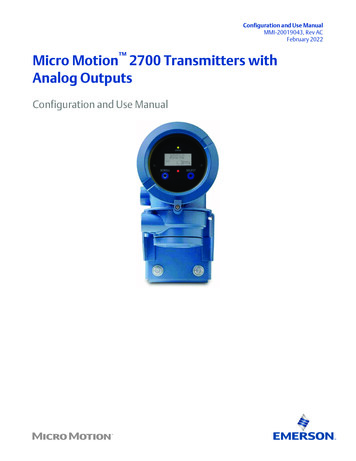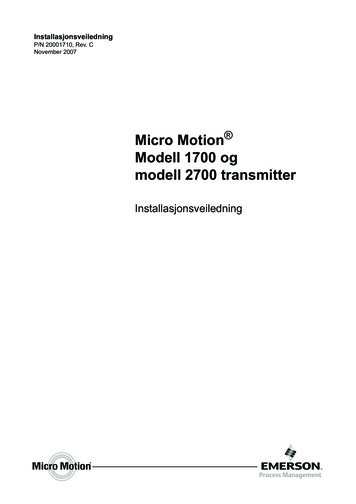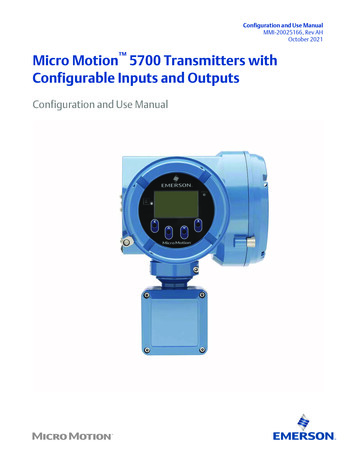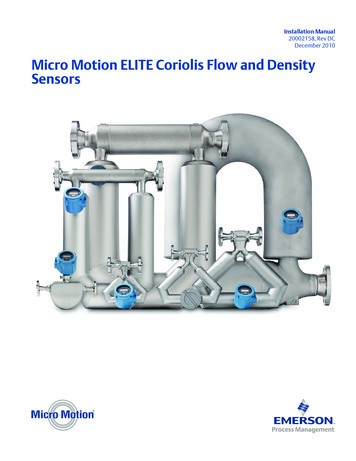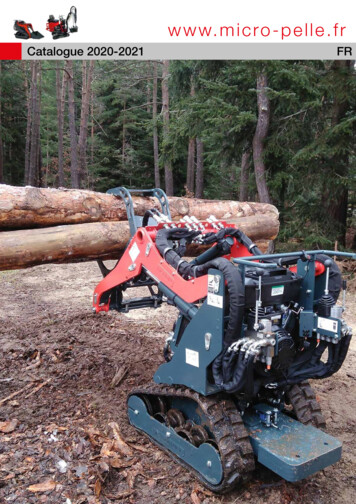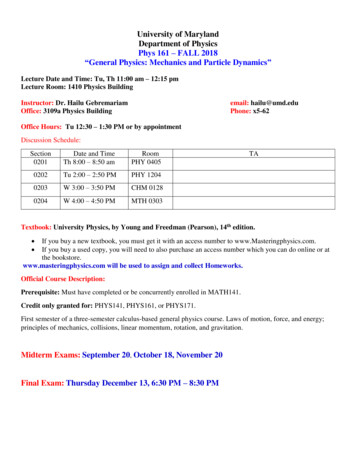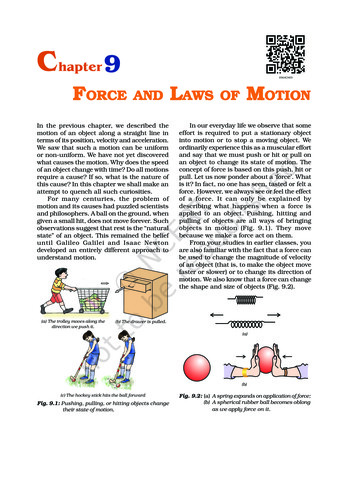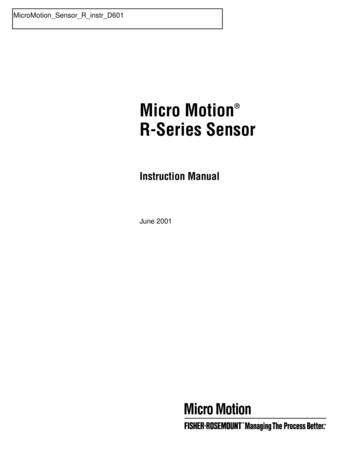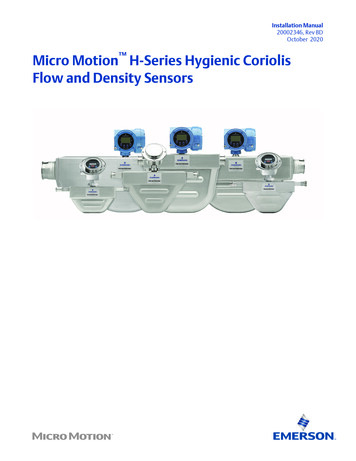
Transcription
Installation Manual20002346, Rev BDOctober 2020Micro Motion H-Series Hygienic CoriolisFlow and Density Sensors
Safety messagesSafety messages are provided throughout this manual to protect personnel and equipment. Read each safety message carefullybefore proceeding to the next step.Safety and approval informationThis Micro Motion product complies with all applicable European directives when properly installed in accordance with theinstructions in this manual. Refer to the EU declaration of conformity for directives that apply to this product. The EU declarationof conformity, with all applicable European directives, and the complete ATEX Installation Drawings and Instructions are availableon the internet at www.emerson.com or through your local Micro Motion support center.Information affixed to equipment that complies with the Pressure Equipment Directive, can be found on the internet atwww.emerson.com.For hazardous installations in Europe, refer to standard EN 60079-14 if national standards do not apply.Other informationFull product specifications can be found in the product data sheet. Troubleshooting information can be found in the configurationmanual. Product data sheets and manuals are available from the Micro Motion web site at www.emerson.com.Return policyFollow Micro Motion procedures when returning equipment. These procedures ensure legal compliance with governmenttransportation agencies and help provide a safe working environment for Micro Motion employees. Micro Motion will not acceptyour returned equipment if you fail to follow Micro Motion procedures.Return procedures and forms are available on our web support site at www.emerson.com, or by phoning the Micro MotionCustomer Service department.Emerson Flow customer serviceEmail: Worldwide: flow.support@emerson.com Asia-Pacific: APflow.support@emerson.comTelephone:2North and South AmericaEurope and Middle EastAsia PacificUnited States800-522-6277U.K. and Ireland0870 240 1978Australia800 158 727Canada 1 303-527-5200The Netherlands 31 (0) 70 4136666New Zealand099 128 804Mexico 52 55 5809 5010France 33 (0) 800 917901India800 440 1468Argentina 54 11 4809 2700Germany0800 182 5347Pakistan888 550 2682Brazil 55 15 3413 8000Italy 39 8008 77334China 86 21 2892 9000Chile 56 2 2928 4800Central & Eastern 41 (0) 41 7686111Japan 81 3 5769 6803Peru 51 15190130Russia/CIS 7 495 995 9559South Korea 82 2 3438 4600Egypt0800 000 0015Singapore 65 6 777 8211Oman800 70101Thailand001 800 441 6426Qatar431 0044Malaysia800 814 008Kuwait663 299 01South Africa800 991 390Saudi Arabia800 844 9564UAE800 0444 0684
Installation Manual20002346ContentsOctober 2020ContentsChapter 1Before you begin. 51.1 About this document. 51.2 Hazard messages. 51.3 Related documentation. 6Chapter 2Planning. 72.1 Installation checklist. 72.2 Best practices. 82.3 Temperature limits. 82.4 Recommendations for hygienic and self-draining applications.9Chapter 3Mounting.113.1 Mount the sensor.113.2 Attach extended electronics. 11Chapter 4Transmitter power and I/O wiring. 134.1 Options for wiring. 134.2 Connect 4-wire cable. 134.3 Connect the 9-wire cable . 17Chapter 5Chapter 6Grounding.19Supplementary information. 216.1 Purge the sensor case .216.2 Pressure relief. 22Installation Manual3
ContentsOctober 20204Installation Manual20002346Micro Motion H-Series
Installation Manual200023461Before you begin1.1About this documentBefore you beginOctober 2020This document provides information on planning, mounting, wiring, and grounding the HSeries sensor.The information in this document assumes that users understand basic transmitter andsensor installation, configuration, and maintenance concepts and procedures.1.2Hazard messagesThis document uses the following criteria for hazard messages based on ANSI standardsZ535.6-2011 (R2017).DANGERSerious injury or death will occur if a hazardous situation is not avoided.WARNINGSerious injury or death could occur if a hazardous situation is not avoided.CAUTIONMinor or moderate injury will or could occur if a hazardous situation is not avoided.NOTICEData loss, property damage, hardware damage, or software damage can occur if asituation is not avoided. There is no credible risk of physical injury.Physical accessNOTICEUnauthorized personnel can potentially cause significant damage and/or misconfigurationof end users' equipment. Protect against all intentional or unintentional unauthorized use.Physical security is an important part of any security program and fundamental toprotecting your system. Restrict physical access to protect users' assets. This is true for allsystems used within the facility.Installation Manual5
Before you beginOctober 20201.3Installation Manual20002346Related documentationYou can find all product documentation on the product documentation DVD shipped withthe product or at www.emerson.com.See any of the following documents for more information: The hazardous area approvals documentation shipped with the sensor or available atwww.emerson.com/flowmeasurement. Micro Motion H-Series Hygienic Coriolis Flow and Density Meters Product Data Sheet Micro Motion 9-Wire Flow Meter Cable Preparation and Installation Guide The transmitter installation and configuration and use guides6Micro Motion H-Series
Installation Manual20002346PlanningOctober 20202Planning2.1Installation checklist Make sure that the hazardous area specified on the approval tag is suitable for theenvironment in which the meter will be installed.WARNINGFailure to abide by approvals can cause an explosion resulting in injury or death. Verify that the local ambient and process temperatures are within the limits of themeter. If your sensor has an integral transmitter, no wiring is required between the sensor andtransmitter. Follow the wiring instructions in the transmitter installation manual forsignal and power wiring. If your transmitter has remote-mounted electronics, follow the instructions in thismanual for wiring between the sensor and the transmitter, and then follow theinstructions in the transmitter installation manual for power and signal wiring.Table 2-1: Maximum cable lengthsCable typeTo transmitterMaximum lengthMicro Motion4-wireAll 4-wire MVD transmitters1,000 ft (305 m) without Ex-approval500 ft (152 m) with IIC-rated sensors1,000 ft (305 m) with IIB-rated sensorsTable 2-2: Maximum lengths for user-supplied 4-wire cableWire functionWire sizeMaximum lengthPower (VDC)22 AWG (0.326 mm²)300 ft (91 m)20 AWG (0.518 mm²)500 ft (152 m)18 AWG (0.823 mm²)1,000 ft (305 m)Signal (RS-485) Installation Manual22 AWG (0.326 mm²) or larger 1,000 ft (305 m)For optimal performance, install the sensor in the preferred orientation. The sensor willwork in any orientation as long as the flow tubes remain full of process fluid.7
PlanningOctober 2020Installation Manual20002346Table 2-3: Preferred sensor orientationProcessPreferred orientationSecondary preferredorientation(1)Alternate suitableorientation(1)Liquids &slurriesGases(1) For meters installed in a horizontal orientation it is recommended to utilize forced expulsionwith pressurized gas where draininability is required. 2.2Install the meter so that the flow direction arrow on the sensor case matches the actualforward flow of the process. (Flow direction is also software-selectable.)Best practicesThe following information can help you get the most from your sensor. There are no pipe run requirements for Micro Motion sensors. Straight runs of pipeupstream or downstream are unnecessary. If the sensor is installed in a vertical pipeline, liquids and slurries should flow upwardthrough the sensor. Gases should flow downward. Keep the sensor tubes full of process fluid. For halting flow through the sensor with a single valve, install the valve downstreamfrom the sensor. The sensor does not require external supports. The flanges will support the sensor inany orientation.2.3Temperature limitsSensors can be used in the process and ambient temperature ranges shown in thetemperature limit graphs. For the purposes of selecting electronics options, temperaturelimit graphs should be used only as a general guide. If your process conditions are close tothe gray area, consult with your Micro Motion representative.Note In all cases, the electronics cannot be operated where the ambient temperature isbelow -40 F (-40.0 C) or above 140 F (60.0 C). If a sensor is to be used where theambient temperature is outside of the range permissible for the electronics, the8Micro Motion H-Series
Installation Manual20002346PlanningOctober 2020electronics must be remotely located where the ambient temperature is within thepermissible range, as indicated by the shaded areas of the temperature limit graphs. Temperature limits may be further restricted by hazardous area approvals. Refer to thehazardous area approvals documentation shipped with the sensor or available from thewww.emerson.com/flowmeasurement. For further questions, contact customerservice. The extended-mount electronics option allows the sensor case to be insulated withoutcovering the transmitter, core processor, or junction box, but does not affecttemperature ratings. When insulating the sensor case at elevated processtemperatures (above 140 F (60.0 C)), please ensure electronics are not enclosed ininsulation as this may lead to electronics failure.Ambient and process temperature limits for all H-Series meters158 (70)140 (60)Tamb–40 (–40)–148(–100)BATproc81(27)400(204)A. All available electronic optionsB. Extended or remote mount electronics only2.4TambAmbient temperature F ( C)TprocProcess temperature F ( C)Recommendations for hygienic and selfdraining applicationsH-Series sensors are self-draining when installed in a vertical pipeline.For optimal cleanability and drainability: If possible, install the sensor in a vertical pipeline with the process fluid flowing upwardthrough the sensor. If the sensor must be installed in a horizontal pipeline, drainage is accomplished by airpurge evacuation of the pipeline circuit. For clean-in-place (CIP) applications, Micro Motion recommends using the generallyaccepted flow velocity of at least 1.5 m/s for cleaning the sensor. The gap between the electronics housing and sensor body should be inspectedperiodically. Manually clean this gap when necessary.Installation Manual9
PlanningOctober 2020Installation Manual20002346 Tri-Clamp and DIN 11851 style process connections require special gaskets to complywith EHEDG requirements for hygienic design.Figure 2-1: Installation for self-draining applicationsABCA. Process pipelineB. Direction of normal process flowC. Direction of drainage10Micro Motion H-Series
Installation Manual200023463Mounting3.1Mount the sensorMountingOctober 2020NOTICE Lifting the sensor by the electronics or purge connections can damage the device. To reduce the risk of collecting liquid in the electronics housing, do not orienttransmitters or sensor junction boxes with their conduit openings pointing upward.ProcedureMount the sensor.Notes Do not use the sensor to support the piping. The sensor does not require external supports. The flanges will support the sensor inany orientation.3.2Attach extended electronicsIf your installation has a sensor with extended electronics, you will need to install theextender onto the sensor case.Extended core processors are matched at the factory to specific sensors. Keep each coreprocessor together with the sensor with which it was shipped.Installation Manual11
MountingOctober 2020Installation Manual20002346NOTICEKeep the extender and feedthrough clean and dry. Moisture or debris in the extender orfeedthrough can damage electronics and result in measurement error or flowmeterfailure.Procedure1. Remove and recycle the plastic cap from the feedthrough on the sensor.Figure 3-1: Feedthrough and extender componentsABCGDEHFA.B.C.D.E.F.G.H.Transmitter or core processorExtenderO-ringFeedthroughClamping ringClamping screwPlastic plugPlastic cap2. Loosen the clamping screw and remove the clamping ring. Leave the O-ring in placeon the feedthrough.3. Remove and recycle the plastic plug from the extender.4. Fit the extender onto the feedthrough by carefully aligning the notches on thebottom of the extender with the notches on the feedthrough.5. Close the clamping ring and tighten the clamping screw to 13 in lbf (1.47 N m) to18 in lbf (2.03 N m).12Micro Motion H-Series
Installation Manual20002346Transmitter power and I/O wiringOctober 20204Transmitter power and I/O wiring4.1Options for wiringThe wiring procedure you follow depends on which electronics option you have.Table 4-1: Wiring procedures by electronics optionElectronics optionWiring procedureIntegral transmitterThe transmitter is already connected to the sensor. No wiring isrequired between sensor and transmitter. See the transmitterinstallation manual for wiring the power and signal cable to thetransmitter.Extended electronicsThe electronics are separated from the sensor by an extender andmust be attached as described in Attach extended electronics.There is no wiring required because the physical connectionincludes the electrical connection.MVD Direct Connect There is no transmitter to wire. See the Micro Motion MVD DirectConnect Meters manual for wiring the power and signal cablebetween the sensor and the direct host.Integral core processor withremote transmitterThe core processor is already connected to the sensor. Connect a4-wire cable between the core processor and transmitter. Referto Connect 4-wire cable.WARNINGMake sure the hazardous area specified on the sensor approval tag is suitable for theenvironment in which the sensor will be installed. Failure to comply with therequirements for intrinsic safety in a hazardous area could result in an explosionresulting in injury or death.NOTICEFully close and tighten all housing covers and conduit openings. Improperly sealedhousings can expose electronics to moisture, which can cause measurement error orflowmeter failure. Inspect and grease all gaskets and O-rings.4.2Connect 4-wire cable4.2.14-wire cable types and usageMicro Motion offers two types of 4-wire cable: shielded and armored. Both types containshield drain wires.The cable supplied by Micro Motion consists of one pair of red and black 18 AWG(0.823 mm²) wires for the VDC connection, and one pair of white and green 22 AWG(0.326 mm²) wires for the RS-485 connection.User-supplied cable must meet the following requirements:Installation Manual13
Transmitter power and I/O wiringOctober 2020Installation Manual20002346 Twisted pair construction. Applicable hazardous area requirements, if the core processor is installed in ahazardous area. Wire gauge appropriate for the cable length between the core processor and thetransmitter, or the host.4.2.2Wire gaugeMaximum cable lengthVDC 22 AWG (0.326 mm²)300 ft (91 m)VDC 20 AWG (0.518 mm²)500 ft (152 m)VDC 18 AWG (0.823 mm²)1,000 ft (305 m)RS-485 22 AWG (0.326 mm²) or larger1,000 ft (305 m)Prepare a cable with a metal conduitProcedure1. Remove the core processor cover using a flat-blade screw driver.2. Run the conduit to the sensor.3. Pull the cable through the conduit.4. Cut the drain wires and let them float at both ends of the conduit.4.2.3Prepare a cable with user-supplied cable glandsProcedure1. Remove the core processor cover using a flat-blade screw driver.2. Pass the wires through the gland nut and gland body.A. Gland bodyB. Gland nut3. Terminate the RS-485 shield and drain wires to the housing internal groundingscrew.4. Assemble the gland according to vendor instructions.4.2.4Prepare a cable with Micro Motion-supplied cable glandsProcedure1. Remove the core processor cover using a flat-blade screw driver.14Micro Motion H-Series
Installation Manual20002346Transmitter power and I/O wiringOctober 20202. Pass the wires through the gland nut and clamping insert.A. Gland nutB. Clamping insert3. Strip the cable jacket.OptionDescriptionNPT gland typeStrip 4.5 in (114 mm)M20 gland typeStrip 4.25 in (108 mm)4. Remove the clear wrap and filler material.5. Strip most of the shielding.OptionDescriptionNPT gland typeStrip all but 0.75 in (19 mm)M20 gland typeStrip all but 0.5 in (13 mm)6. Wrap the drain wires twice around the shield and cut off the excess drain wires.A. Drain wires wrapped around shield7. For foil (shielded cable) only:NoteFor braided (armored cable) skip this step and contine to the next step.OptionNPTglandtypeDescriptiona. Slide the shielded heat shrink over the drain wires. Ensure that thewires are completely covered.b. Apply 250 F (121.1 C) heat to shrink the tubing. Do not burn thecable.c. Position the clamping insert so the interior end is flush with thebraid of the heat shrink.Installation Manual15
Transmitter power and I/O wiringOctober 2020OptionInstallation Manual20002346DescriptionA. Shielded heat shrinkB. After heat is appliedM20glandtypeTrim 0.3 in (8 mm).A. Trim8. Assemble the gland by folding the shield or braid back over the clamping insert and0.125 in (3 mm) past the O-ring.A. Shield folded back9. Install the gland body into the conduit opening on the core processor housing.10. Insert the wires through the gland body and tighten the gland nut onto the glandbody.A. Shield folded backB. Gland body4.2.5Connect the wires to the core processor terminalsAfter the 4-wire cable has been prepared and shielded (if required), connect the individualwires of the 4-wire cable to the terminals on the core processor.Procedure1. Connect the wires to the core processor terminals.16Micro Motion H-Series
Installation Manual20002346Transmitter power and I/O wiringOctober 20202. Reinstall the core processor cover.3. Torque the cover screws to: For aluminum housing: 10 in lbf (1.13 N m) to 13 in lbf (1.47 N m) For stainless steel housing: minimum 19 in lbf (2.15 N m)If properly seated, there will be no gap between cover and base.4. Connect the wires to the transmitter terminals using the transmitter installationmanual.4.3Connect the 9-wire cableProcedure1. Prepare and install the cable according to the instructions in the Micro Motion 9-WireFlow Meter Cable Preparation and Installation Guide.2. Insert the stripped ends of the individual wires into the terminal blocks of thejunction box. Ensure that no bare wires remain exposed.3. Match the wires color for color. For wiring at the transmitter or remote coreprocessor, refer to the transmitter documentation.4. Tighten the screws to hold the wires in place.5. Ensure integrity of gaskets, then tightly close and seal the junction box cover and allhousing covers.6. Refer to the transmitter installation manual for signal and power wiringinstructions.Installation Manual17
Transmitter power and I/O wiringOctober 202018Installation Manual20002346Micro Motion H-Series
Installation Manual200023465GroundingOctober 2020GroundingThe meter must be grounded according to the standards that are applicable at the site.The customer is responsible for knowing and complying with all applicable standards.PrerequisitesUse the following guides for grounding practices: In Europe, IEC 60079-14 is applicable to most installations, in particular sections16.2.2.3 and 16.2.2.4. In the U.S.A. and Canada, ISA 12.06.01 Part 1 provides examples with associatedapplications and requirements.If no external standards are applicable, follow these guidelines to ground the sensor: Use copper wire, 14 AWG (2.08 mm²) or larger wire size. Keep all ground leads as short as possible, less than 1 Ω impedance. Connect ground leads directly to earth, or follow plant standards.NOTICEGround the flowmeter to earth, or follow ground network requirements for the facility.Improper grounding can cause measurement error.Procedure Check the joints in the pipeline. If the joints in the pipeline are ground-bonded, the sensor is automaticallygrounded and no further action is necessary (unless required by local code). If the joints in the pipeline are not grounded, connect a ground wire to thegrounding screw located on the sensor electronics.TipThe sensor electronics may be a transmitter, core processor, or junction box. Thegrounding screw may be internal or external.Installation Manual19
GroundingOctober 202020Installation Manual20002346Micro Motion H-Series
Installation Manual20002346Supplementary informationOctober 20206Supplementary information6.1Purge the sensor casePrerequisitesMake sure the following are available before beginning the purge procedure: Teflon tape Argon or nitrogen gas sufficient to purge the sensor caseWhenever a purge plug is removed from the sensor case, you must purge the case again.Procedure1. Shut down the process, or set control devices for manual operation.NOTICEBefore performing the case purging procedure, shut down the process or set thecontrol devices for manual operation. Performing the purge procedure while theflowmeter is operating could affect measurement accuracy, resulting in inaccurateflow signals.2. Remove both purge plugs from the sensor case. If purge lines are being used, openthe valve in the purge lines.WARNING If a rupture disk has been installed on the purge fitting, stay clear of therupture disk pressure relief area. High-pressure fluid escaping from the sensorcan cause severe injury or death. Orient the sensor so that personnel andequipment will not be exposed to any discharge along the pressure relief path. Take all necessary precautions when removing purge plugs. Removing a purgeplug compromises the secondary containment of the sensor and could exposethe user to process fluid. Improper pressurization of the sensor case could result in injury.NOTICEIf a rupture disk has been installed on the purge fitting, use thread protectors whenremoving the purge fitting so as not to damage the disk membrane surroundingthe rupture disk.3. Prepare the purge plugs for reinstallation by wrapping them with 2–3 turns ofTeflon tape.4. Connect the supply of nitrogen or argon gas to the inlet purge connection or openinlet purge line. Leave the outlet connection open.NOTICE Exercise caution to avoid introducing dirt, moisture, rust, or other contaminantsinto the sensor case.Installation Manual21
Supplementary informationOctober 2020Installation Manual20002346 If the purge gas is heavier than air (such as argon), locate the inlet lower than theoutlet, so that the purge gas will displace air from bottom to top. If the purge gas is lighter than air (such as nitrogen), locate the inlet higher thanthe outlet, so that the purge gas will displace air from top to bottom.5. Make sure that there is a tight seal between the inlet connection and sensor case, sothat air cannot be drawn by suction into the case or purge line during the purgingprocess.6. Run purge gas through the sensor.The purge time is the amount of time required for full exchange of atmosphere toinert gas. The larger the line size, the greater amount of time is required to purgethe case. If purge lines are being used, increase the purge time to fill the additionalvolume of the purge line.ImportantKeep the purge gas pressure below 7.25 psi (0.5 bar).Table 6-1: Purge timeSensor modelPurge rateTime, in minutesH02520 ft3/h (566.3 l/h)4 1/2H05020 ft3/h (566.3 l/h)4 1/2H10020 ft3/h (566.3 l/h)6H20020 ft3/h (566.3 l/h)15H30020 ft3/h (566.3 l/h)25H40020 ft3/h (566.3 l/h)257. At the appropriate time, shut off the gas supply, then immediately seal the purgeoutlet and inlet connections with the purge plugs.Avoid pressurizing the sensor case. If pressure inside the case elevates aboveatmospheric pressure during operation, the flowmeter density calibration will beinaccurate.8. Make sure that the purge fitting seals are tight so that air cannot be drawn bysuction into the sensor case.6.2Pressure reliefH-Series sensors are available with a rupture disk installed on the case. Rupture disks ventprocess fluid from the sensor case in the unlikely event of a flow tube breach. Some usersconnect a pipeline to the rupture disk to help contain escaping process fluid. For moreinformation about rupture disks, contact customer service.If the sensor has a rupture disk, keep it installed at all times as it would otherwise benecessary to re-purge the case. If the rupture disk is activated by a tube breach, the seal inthe rupture disk will be broken, and the Coriolis meter should be removed from service.22Micro Motion H-Series
Installation Manual20002346Supplementary informationOctober 2020WARNING Orient the sensor so that personnel and equipment will not be exposed to anydischarge along the pressure relief path. Stay clear of the rupture disk pressure relief area. High-pressure fluid escaping fromthe sensor can cause severe injury or death.ImportantIf using a rupture disk, the housing can no longer assume a secondary containmentfunction.NOTICERemoving the purge fitting, blind plug, or rupture disks compromises the Ex-i SafetyCertification, the Ex-tc Safety Certification, and the IP-rating of the Coriolis meter. Anymodification to the purge fitting, blind plug, or rupture disks must maintain a minimum ofIP66/IP67 Ratings.Installation Manual23
*20002346*20002346Rev. BD2020Micro Motion Inc. USA7070 Winchester CircleBoulder, Colorado USA 80301T 1 303-527-5200T 1 800-522-6277F 1 303-530-8459www.emerson.comMicro Motion EuropeEmerson Automation SolutionsNeonstraat 16718 WX EdeThe NetherlandsT 31 (0) 318 495 555T 31 (0) 70 413 6666F 31 (0) 318 495 556www.emerson.com/nl-nlMicro Motion AsiaEmerson Automation Solutions1 Pandan CrescentSingapore 128461Republic of SingaporeT 65 6363-7766F 65 6770-8003Micro Motion United KingdomEmerson Automation SolutionsEmerson Process Management LimitedHorsfield WayBredbury Industrial EstateStockport SK6 2SU U.K.T 44 0870 240 1978F 44 0800 966 181 2020 Micro Motion, Inc. All rights reserved.The Emerson logo is a trademark and service mark of Emerson Electric Co. Micro Motion, ELITE,ProLink, MVD and MVD Direct Connect marks are marks of one of the Emerson AutomationSolutions family of companies. All other marks are property of their respective owners.
Troubleshooting information can be found in the configuration manual. Product data sheets and manuals are available from the Micro Motion web site at www.emerson.com. . Micro Motion 9-Wire Flow Meter Cable Preparation and Installation Guide The transmitter installation and configuration and use guides Before you begin Installation .
